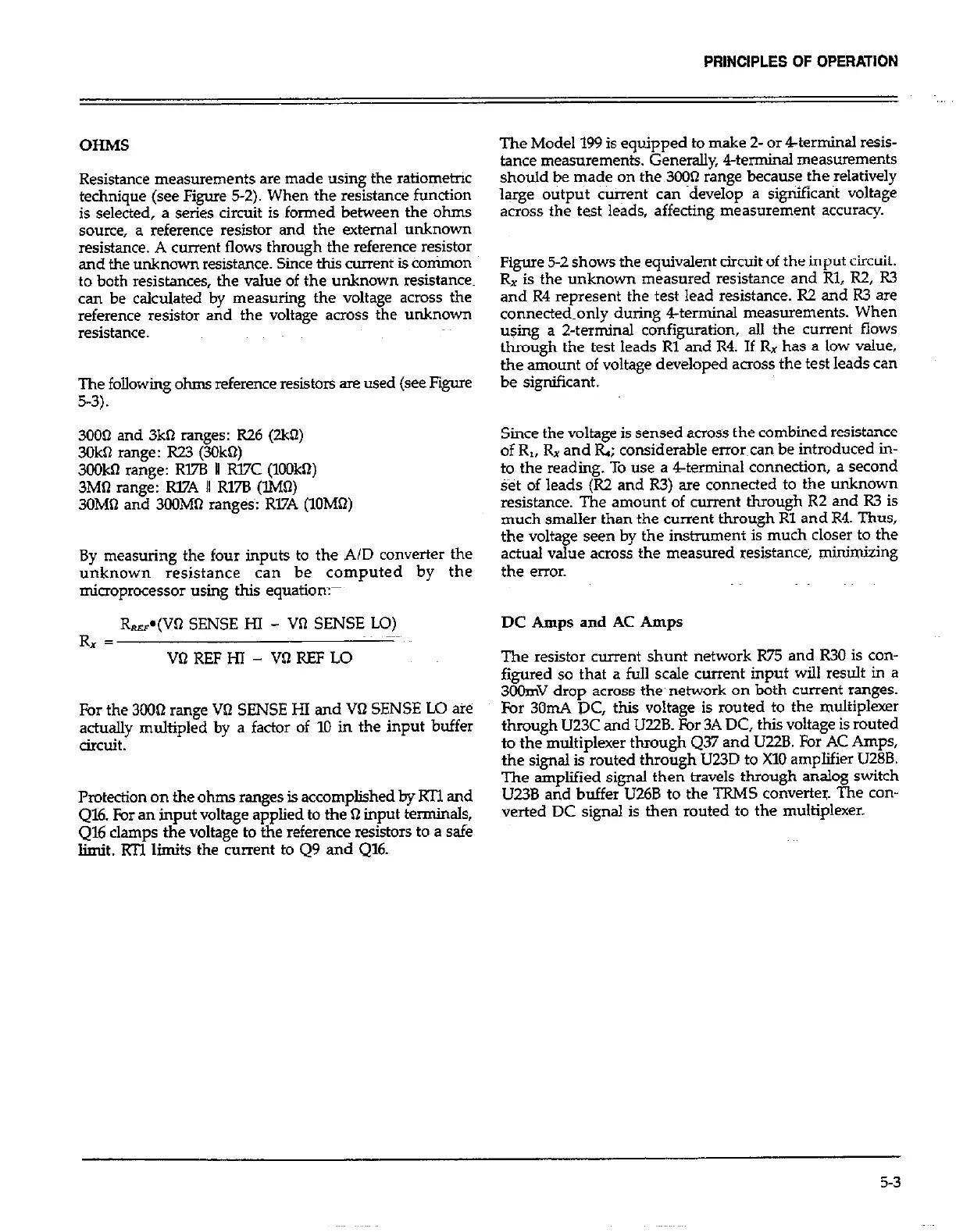OHMS
Resistance measurements are made using the ratiometric
technique (see Figure 5-2). When the resistance function
is selected, a series circuit is formed between the ohms
source, a reference resistor and the external unknown
resistance. A current flows through the reference resistor
and the unknown resistance. Since this current is &&non
to both resistances, the value of the unknown resistance
can be calculated by measuring the voltage across the
reference resistor and the voltage across the unknown
resistance.
TIE following ohms reference resistors are used (see Figure
5-3).
3OOn and 3kKl ranges: R26 (2kn)
3Okoka range: R23 (3Ok@
3OOkR &ge: RI76 I R&C (lOOk0)
3MR range: Rl7A II Rl7B (IMQ)
3OMll and 3OOMR ranges: Rl7A (lOM@
By measuring the four inputs to the AID converter the
unknown resistance can be computed by the
microprocessor using this equatiorr
R,,*(VQ SENSE Hl - VR SENSE LO)
Rx =
VQ REF Hl - VR REF LO
For the 3000 range Vfl SENSE HI and VQ SENSE M tie
atially multipled by a factor of 10 in the input buffer
circuit.
Protection on the ohms ranges is accomplished by Rl’l and
Ql6. For an input voltage applied to the 0 input terminals,
Ql6 clamps the voltage to the reference resistors to a safe
hit. RTI limits the current to Q9 and 4%.
The Model 199 is equipped to make 2- or 4terminal resis-
tance measurements. Generally, 4-terminal measurements
should be made on the~3OOll range because the relatively
large output current can develop a signicatit voltage
across the test leads, affecting measurement accuracy.
Figure 5-2 shows the equivalent circuit of the input circuit.
Rx is the unknown measured resistance and Rl, R2, R3
and R4 represent the test lead resistance. R2 and R3 are
connected~only during 4-terminal measurements. When
using a Z-terminal configuration, all the current flows
through the test leads Rl and R4. If Rx has a low value,
the amount of voltage developed ac~oss the test leads can
be significant.
Since the voltage is sensed across the combined resistance
of R,, Rx and R.; considerable error~can be introduced in-
to the reading. To use a 4terminal connection, a second
set of leads (R2 and R3) are connected to the unknown
resistance. The amount of current through R2 and R3 is
much smaller than the current through Rl and R4. Thus,
the voltage seen by the instrument is much closer to the
actual value across the measured resistance; minimizing
the error.
DC Amps and AC Amps
The resistor current shunt network R75 and R30 is con-
figured so that a full scale current input will result in a
3OOrV drop across the network on both current ranges.
For 3OmA DC, this voltage is routed to the multiplexer
through U23C and U2ZB. For 3A DC, this voltage is routed
to the multiplexer through Q37 and U22B. For AC Amps,
the signal is routed through U23D to X10 amplifier U28B.
The amplified signal then travels through analog switch
U23B and buffer U26B to the TRh4S converter. The con-
verted DC signal is then routed to the multiplexer.
5-3
